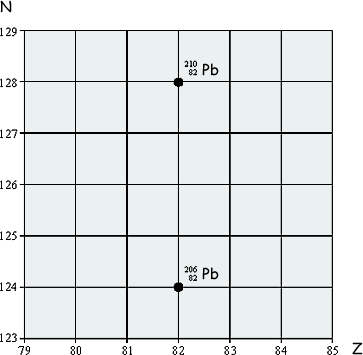A level: Radioactivity Questions
Q16.
(a) The lead nuclide  is unstable and decays in three stages through α and β emissions to a different lead nuclide
is unstable and decays in three stages through α and β emissions to a different lead nuclide  . The position of these lead nuclides on a grid of neutron number, N, against proton number, Z, is shown on the grid below:
. The position of these lead nuclides on a grid of neutron number, N, against proton number, Z, is shown on the grid below:

On the grid draw three arrows to represent one possible decay route.
Label each arrow with the decay taking place.
(3 marks)
(b) The copper nuclide  may decay by positron emission or by electron capture to form a nickel (chemical symbol - Ni) nuclide. Write the two equations that represent these two possible modes of decay.
may decay by positron emission or by electron capture to form a nickel (chemical symbol - Ni) nuclide. Write the two equations that represent these two possible modes of decay.
(4 marks)
(c) The nucleus of an atom may be investigated by scattering experiments in which radiation or particles bombard the nucleus.
Name one type of radiation or particle that may be used in this investigation and describe the main physical principle of the scattering process.
State the information which can be obtained from the results of this scattering.
(3 marks)
(Total 10 marks)



